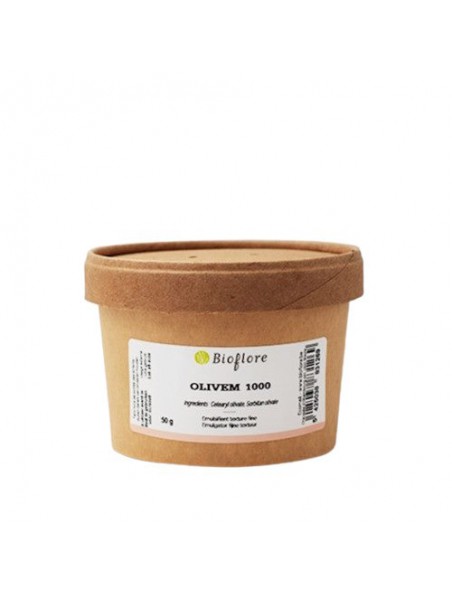Description :
Emulsifiant dérivé de l'huile d'olive et du sorbitan végétal, 100% biodégradable, permettant la réalisation facile d'émulsions très fines et pénétrantes avec des textures en parfaite affinité avec la peau.
Il apportera un effet émollient et hydratant ainsi qu'un toucher soyeux à vos crèmes.
Propriétés :
• Emulsifiant "huile dans eau".
Indications :
• Pour émulsion crémeuse.
Dosage :
De 2 à 4% du poids total pour une lotion.
De 5 à 8% du poids total pour une crème.
1ml = 1g.
Point de fusion : 65-75°.
Composition :
Cetearyl olivate, sorbitan olivate.
Recette d’une crème du jour hydratante à la vanille et à l’ylang-ylang, mettant en oeuvre l'émulsifiant Olivem (provenant du site bioflore) :
Résultat : crème onctueuse, riche mais très pénétrante, léger effet tenseur.
Pour 50 ml de préparation :
Phase aqueuse (70%) :
16,5 ml d’eau minérale
10 ml d’hydrolat de bleuet
2,5 ml de gel d’aloe vera
0,8 g de gomme xanthane
4,5 ml de glycérine végétale
0,15 ml (0,16 g) d’acide citrique
Phase huileuse (30%):
5 ml d’huile végétale d’amande douce
5 ml d’huile végétale de jojoba
1,9 g d’émulsifiant Olivem 1000 (présenté sur cette page)
1,6 g de beurre de karité
Conservateurs :
Vitamine E : 0,1 ml
Cosgard : 0,3 ml
Part aromatique (1-3%) :
ylang-ylang 1goutte, vanille bourbon dilution : 4 gouttes
Remarque :
Par l'ajout en phase aqueuse de protéines de riz, on obtient un toucher plus doux et plus souple à la peau ou par l’ajout de protéines de soie à raison de 0,5-5% vous bénéficierez d’un effet additionnel hydratant en cas de peau fort déshydratée.
Mode d’emploi :
1) Transférez la phase aqueuse, hormis l’aloe vera et la glycérine, à chauffer dans un bol au bain-marie. Attention : l’aloe et la glycérine seront rajoutés lors de l’étape de refroidissement du gel aqueux.
2) Dans un autre bol, rassemblez les ingrédients de la phase huileuse.
3) Faites chauffer séparément au bain-marie les deux phases, la phase aqueuse ne doit pas dépasser 45°C afin de ne pas dégrader les propriétés de l’hydrolat.
4) La phase huileuse peut atteindre 70°C. La phase huileuse est prête lorsque le mélange a un aspect homogène et translucide sans résidus flottants. Il est très important de ne pas sous-estimer la chauffe de cette phase ! Ensuite, laissez refroidir légèrement.
5) Rajouter l’aloe et la glycérine dans la phase aqueuse.
6) Lorsque les deux phases sont approximativement à la même température (+/35-50°C), versez lentement la phase huileuse dans la phase aqueuse sans cesser d'agiter vigoureusement au mini-fouet pendant environ 3 minutes. Le mélange blanchit et s'homogénéise.
7) Sans cesser d'agiter, mettez le bol dans un fond d'eau froide afin d'accélérer le refroidissement et la prise de l'émulsion pendant encore 3 minutes environ.
8) Ajoutez progressivement les conservateurs et la part aromatique, en mélangeant bien entre chaque ajout.
9) Transférez la préparation dans votre pot de 50 ml. N’oubliez pas d’étiqueter.
Conditionnement :
50 grammes, dans son pot blanc.
La marque :
Par notre présence à divers salons consacrés aux médecines douces et, de manière privilégiée, aux salons « Nature & Progrès », nous avons largement contribué à la diffusion et à la popularité de l’aromathérapie et, de manière générale, de toutes les manières d’utiliser les huiles essentielles pures et naturelles dans divers domaines de la vie courante.
Par nos cycles de formations, organisés par le fondateur de la société, André Bitsas, nous avons initié bon nombre de professionnels de la santé et de particuliers décidés à prendre en main leur propre bien-être et celui de leurs proches.
André Bitsas est l’auteur du livre Aromathérapie Corps et Âme, paru aux éditions Amyris. Clé de voûte de notre activité, notre gamme d’huiles essentielles pures, naturelles, chémotypées et biologiques Bioflore. Ajoutons-y ces compléments indispensables des huiles essentielles que sont les huiles végétales, les hydrolats, les excipients et bases neutres, le matériel nécessaire pour réaliser vos propres préparations.
Les références biologiques de la marque Bioflore sont contrôlées par l’organisme de contrôle officiel et indépendant Certisys.









 Nous vous conseillons aussi
Nous vous conseillons aussi
